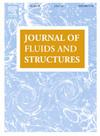Large eddy simulation of tip and Karman vortices around a square prism: dynamic characteristics and their impact on lift force
IF 3.4
2区 工程技术
Q1 ENGINEERING, MECHANICAL
引用次数: 0
Abstract
As a crucial component in the wind resistance design framework, flow-around analysis plays an essential role in assessing wind effects on structures. In this study, the dynamic behavior of tip- and Karman vortex around a ground-mounted finite length square prism (with an aspect ratio H/B = 9) subjected to atmospheric boundary layer flow representative of suburban terrain, and their relationship to lift force are investigated using large eddy simulation (LES). The Reynolds number based on the square prism width and incoming velocity is . By combining with multiple-point synchronous pressure measurements and particle image velocimetry (PIV) wind tunnel tests, as well as other existing research, the wind loads characteristics are thoroughly examined from the perspective of mean and fluctuating wind pressure distribution on the model surface, local aerodynamic force distribution and overturning moments. Through time- and frequency domain analysis, two distinct lift fluctuation patterns are identified. The three-dimensional vortex structure analysis reveals that the Low-Amplitude Fluctuation (LAF) and High-Amplitude Fluctuation (HAF) of the lift force correspond to symmetrical and alternating vortex-shedding patterns, respectively. Symmetrical vortex shedding is primarily influenced by the downwash of tip vortex, while alternating vortex shedding pattern is driven by the Karman vortex. The notable differences in lift force fluctuation characteristics at various spanwise positions are associated with the range of influence exerted by the tip vortex downwash near the top of the square prism. The identification of the two lift force fluctuation patterns has practical implications for wind load assessment and structural design.
方棱镜尖涡和卡门涡的大涡模拟:动态特性及其对升力的影响
绕流分析作为抗风设计框架的重要组成部分,在评估结构的风作用中起着至关重要的作用。本文采用大涡模拟(LES)方法,研究了地面有限长宽高比H/B = 9的方形棱镜在大气边界层流作用下的顶涡和卡门涡的动力学行为及其与升力的关系。基于方棱镜宽度和入射速度的雷诺数为Re=3.0×104。结合多点同步压力测量和粒子图像测速(PIV)风洞试验等已有研究,从模型表面平均风压分布、脉动风压分布、局部气动力分布和倾覆力矩等角度对风荷载特性进行了深入研究。通过时域和频域分析,确定了两种不同的升力波动模式。三维涡结构分析表明,升力的低振幅波动(LAF)和高振幅波动(HAF)分别对应于对称和交替的涡脱落模式。对称型涡脱落主要受顶涡下洗的影响,而交替型涡脱落主要受卡门涡驱动。不同展向位置升力波动特性的显著差异与靠近方形棱镜顶部的尖涡下洗所施加的影响范围有关。两种升力波动模式的识别对风荷载评估和结构设计具有实际意义。
本文章由计算机程序翻译,如有差异,请以英文原文为准。
求助全文
约1分钟内获得全文
求助全文
来源期刊

Journal of Fluids and Structures
工程技术-工程:机械
CiteScore
6.90
自引率
8.30%
发文量
173
审稿时长
65 days
期刊介绍:
The Journal of Fluids and Structures serves as a focal point and a forum for the exchange of ideas, for the many kinds of specialists and practitioners concerned with fluid–structure interactions and the dynamics of systems related thereto, in any field. One of its aims is to foster the cross–fertilization of ideas, methods and techniques in the various disciplines involved.
The journal publishes papers that present original and significant contributions on all aspects of the mechanical interactions between fluids and solids, regardless of scale.
 求助内容:
求助内容: 应助结果提醒方式:
应助结果提醒方式:


